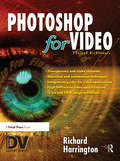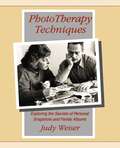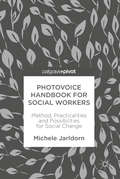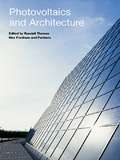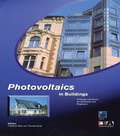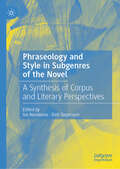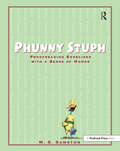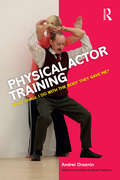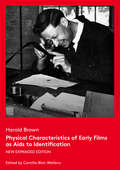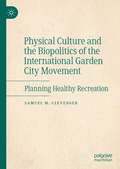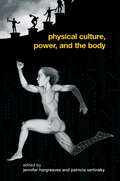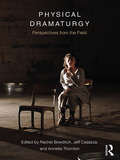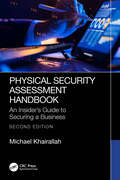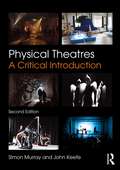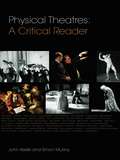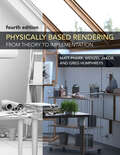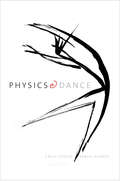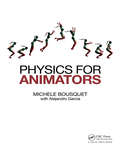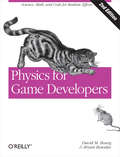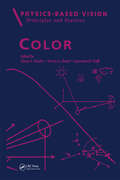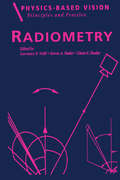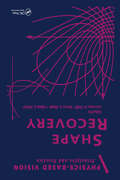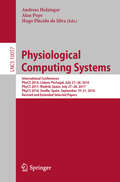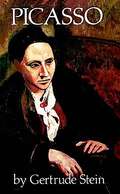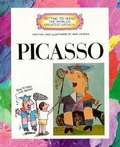- Table View
- List View
Photoshop for Video
by Richard HarringtonMaster the graphic design and production skills required of today's video editors and motion graphic professionals with this comprehensive guide to the video tools in Adobe Photoshop CS3. Every page is filled with techniques to help the video professional make graphics for use in television, video, the Internet, and DVD. Lively discourse, full-color presentations, and hands-on tutorials demonstrate everything you need to know about how to combine still and moving images. Fundamental concepts such as transparency, pixel aspect ratio, and alpha channels are made precisely clear, and advanced techniques show how to use Photoshop as a character generator, color corrector, and animation tool.This edition features expanded coverage of DVD and motion graphics design, as well as addressing recent developments in High Definition video and 32-bit imaging. This indispensable reference includes:* real-world solutions for making graphics for video* introduction to third party plug-ins* automation and shortcut methods that cut production time* profiles of notable editors and motion graphic artists that include their favorite tips and tricksThe DVD offers a hands-on multimedia experience with hundreds of images to work on, tutorials to complete and 2 ½ hours of video training to watch.
Phototherapy Techniques: Exploring the Secrets of Personal Snapshots and Family Albums
by Judy Weiser PhotoTherapy Centre Staff"PhotoTherapy Techniques: Exploring the Secrets of Personal Snapshots and Family Albums" is the most comprehensive introduction to the field of PhotoTherapy available. Emphasizing the "what", "why", and "how" of these practical techniques, this book has long been considered an excellent substitute for a training workshop! <p><p> Written by Canadian psychologist, art therapist, consultant, trainer, and PhotoTherapy pioneer Judy Weiser, this book (now in second edition) explains and demonstrates each of the major techniques involved, and provides theoretical rationale from both psychology and art therapy contexts. It also includes many photo-illustrated client examples, case transcripts, and practical experiential "starter" exercises so that readers can immediately begin using these techniques in their own practice. <p><p> This book is about photography as "personally-symbolic communication", rather than "art" -- exploring what a photograph is about emotionally, in addition to what shows on its surface visually. Thus these techniques require no previous experience with cameras or photographic art -- and they can therefore be used successfully by therapists of all theoretical orientations, work settings, or client specializations. <p><p> Often used as a text for university courses as well as for "Continuing Education" licensing credits for numerous mental health professions, this book is a "must" for not only therapists and counselors, but also anyone interested in coaching, personal development, art therapy, social change, diversity training, conflict resolution, special education, community development, visual literacy, visual anthropology/sociology, visual-based research, and even scrapbooking! <p><p> Though long-considered a "classic" for teaching how to use photos in people-helping work, this book is still even more relevant in this "digital age" of mobile phone pictures and online sharing (because it is about the "heart part" of these images rather than their "art part!"!) -- and thus not at all dependent upon which kind of technology created them! <p><p> *For more information, see her Website "PhotoTherapy & Therapeutic Photography Techniques", at: www.phototherapy-centre.com
Photovoice Handbook for Social Workers: Method, Practicalities and Possibilities for Social Change
by Michele JarldornThis book provides inspiration for social workers to explore the possibilities of using Photovoice to engage with communities. Built on strong theoretical foundations and grounded in ethical principles, Jarldorn assesses Photovoice as an arts-based approach that provides a valuable mechanism for social workers to engage people in participatory action research, with the potential to influence policy and public opinion. Positioning Photovoice as a method aligned with feminist and radical social work perspectives, the author draws upon her research project which used Photovoice with former prisoners to demonstrate the transformative potential of participatory methods. Photovoice Handbook for Social Workers is intended to be a useful, hands-on resource, combining the importance of theory and the practicalities of doing action research.
Photovoltaics and Architecture
by Randall Thomas Max FordhamPhotovoltaic systems (PVs) produce electricity directly from solar radiation and are becoming more widespread as their advantages become apparent. This new guide provides an overview of how PVs work and how they are incorporated in the design of buildings, giving designers a good idea of the variety and flexibility of PVs and of their design and aesthetic potential. Seven contemporary case studies illustrate the use and application of photovoltaic systems.
Photovoltaics in Buildings: A Design Handbook for Architects and Engineers
by Friedrich SickThe integration of photovoltaics (PV) into buildings goes beyond energy saving by providing a clean and elegant way of actually generating electricity. There are already numerous successful examples and rapid technological improvements promise expansion of PV's present niche market to that of a major energy provider of the 21st century. This handbook is the outcome of a five year programme which took place under the auspices of the International Energy Agency. Architects and solar experts from 13 countries addressed the wide range of engineering and architectural issues involved in the successful integration of PV into buildings. It demonstrates how to maximise the overall solar contribution to the building; integrate PV effectively with the building structure; clarify the relationship of PV with other elements of the building's energy system; optimise the system economics. It forms a thorough design guide that covers all aspects if the subject and will enable all building designers, engineers and property owners to make the integration of PV into buildings an architecturally appealing and energetically effective option.
Phraseology and Style in Subgenres of the Novel: A Synthesis of Corpus and Literary Perspectives
by Iva Novakova Dirk SiepmannThis edited book represents the first cohesive attempt to describe the literary genres of late-twentieth-century fiction in terms of lexico-grammatical patterns. Drawing on the PhraseoRom international project on the phraseology of contemporary novels, the contributed chapters combine literary studies with corpus linguistics to analyse fantasy, romance, crime, historical and science fiction in French and English. The authors offer new insights into long-standing debates on genre distinction and the hybridization of genres by deploying a new, interdisciplinary methodology. Sitting at the intersection of literature and linguistics, with a firm grounding in the digital humanities, this book will be of particular relevance to literary scholars, corpus stylists, contrastivists and lexicologists, as well as general readers with an interest in twentieth-century genre fiction.
Phunny Stuph: Proofreading Exercises With a Sense of Humor (Grades 7-12)
by M. S. SamstonYour students will really pay attention when you use Phunny Stuph. Jokes and humorous urban legends make up all 100 proofreading exercises in this useful book. Use the exercises as a class warm-up, or photocopy them to pass out to your students. The errors include a little bit of everything—missing punctuation, spelling mistakes, errors in usage, sentence fragments, and more. Each exercise includes teaching notes and an example showing possible corrections. Most of the exercises are short—just right for quick, frequent lessons that will really help your students improve their skills.Phunny Stuph helps students sharpen their skills at recognizing and correcting errors in spelling, punctuation, capitalization, sentence structure, and usage.Grades 7-12
Physical Actor Training: What Shall I Do with the Body They Gave Me?
by Andrei DrozninIf, as an actor, your body is your 'instrument' - and the only way you can express the internal impulses of the character you’re playing - what happens when the body-mind, ‘psychophysical’ connection is lost? Andrei Droznin, Russia's foremost teacher of physical actor training, calls this loss the 'desomatization' of the human body, and argues that these connections urgently need to be restored for full expressivity. This is a genuinely unique book which links theory to practice by a man who has worked at the very top of Russian theatre; a movement specialist who has taught at the Moscow Art Theatre as well as drama schools all over the world. Beautifully translated by Natasha Fedorova, this volume will excite and inspire a new generation of English-language readers.
Physical Characteristics of Early Films as Aids to Identification: New expanded Edition
by Camille Bolt-WellensAny archivists who have held a piece of fi lm in their hands, wondering how to go about identifying it, recognize the true value of fi lm preservationist Harold Brown's work. In 1967 Brown delivered a pioneering lecture on the identification of early films at the annual Congress of the International Federation of Film Archives (FIAF) in East Berlin. Years of working with Britain's National Film Archive collections, and the close examination of thousands of nitrate prints of the silent period, made Brown a leading authority on early fi lm identification, and an unsurpassed model of methodological consciousness in the archival field. In 1990, FIAF published Brown's Physical Characteristics of Early Films as Aids to Identification, an updated version and a continuation of his 1967 lecture. This publication has long been archivists' trusted companion, constituting a concentrated encyclopedia on all the information that can be discovered or verified through aspects of the fi lm other than the actual projected image – such as perforation shapes; embossed and punched marks; stock manufacturers' and producers' edge marks; frame characteristics; title styles; and production serial numbers. It also included essays on key individual production companies of the silent era. Over the last 30 years, this manual – a basic typewritten 100-page volume (including 20 pages of black & white illustrations), with its easily recognizable red cover – has been an invaluable reference for fi lm archivists and scholars. However, as Brown himself acknowledged in the 1990 edition, the manual was far from definitive. Camille Blot-Wellens, the editor of this new, expanded edition of Brown's 1990 book, belongs to the new generation of researchers who have used Physical Characteristics extensively in their work and have gathered considerable new information on the subject. This new edition is the result of a project she initiated in 2014 with FIAF's support. Brown's original text is now augmented with new original research on key fi lm manufacturers and producers by Camille Bolt-Wellens and other leading archivists and researchers in the field. Richly illustrated (the book contains over 900 images, including 125 in full color), this new 336-page edition of Harold Brown's seminal manual will be welcomed by many, and will no doubt become a must-have working tool for many in the fi lm archiving and academic fields.
Physical Culture and the Biopolitics of the International Garden City Movement: Planning Healthy Recreation
by Samuel M. ClevengerThis book revisits the history of the international garden city town planning movement in the early twentieth century, focusing on the significance of various forms of 'physical culture' - sport, recreation, leisure, and other active body practices - within garden city planning discourse and the development of some of the first garden city communities in the United Kingdom and United States.
Physical Culture, Power, and the Body (Routledge Critical Studies in Sport)
by Patricia Vertinsky Jennifer HargreavesDuring the past decade, there has been an outpouring of books on 'the body' in society, but none has focused as specifically on physical culture - that is, cultural practices such as sport and dance within which the moving physical body is central. Questions are raised about the character of the body, specifically the relation between the ‘natural’ body, the ‘constructed’ body and the ‘alien’ or ‘virtual’ body. The themes of the book are wide in scope, including: physical culture and the fascist body sport and the racialised body sport medicine, health and the culture of risk the female Muslim sporting body, power, and politics experiencing the disabled sporting body embodied exhibitions of striptease and sport the social logic of sparring sport, girls and the neoliberal body. Physical Culture, Power, and the Body aims to break down disciplinary boundaries in its theoretical approaches and its readership. The author’s muli-disciplinary backgrounds, demonstrate the widespread topicality of physical culture and the body.
Physical Dramaturgy: Perspectives from the Field
by Rachel Bowditch Jeff Casazza Annette ThorntonWhat is physical dramaturgy? While the traditional dramaturg shares research intellectually, the physical dramaturg does so viscerally and somatically. By combining elements of text, history, dramatic structure, and the author’s intent with movement analysis and physical theatre pedagogies, the physical dramaturg gives actors the opportunity to manifest their work in a connected and intuitive manner and creates a field that is as varied and rich as the theatre itself. Physical Dramaturgy: Perspectives from the Field explores the ways in which this unique role can benefit the production team during the design and rehearsal phases of both traditional and devised productions. Individual chapters look at new ways of approaching a wealth of physical worlds, from the works of Shakespeare and other period playwrights to the processes of Jerzy Grotowski, Lloyd Williamson, Richard Schechner, and Michael Chekhov, and devising original works in a variety of contexts from Pig Iron, Dell’Arte International, Bill Bowers and mime, Tectonic Theater Project, and Liz Lerman’s Dance Exchange. This anthology gives dramaturgs, actors, and directors new ways of looking at existing methods and provides examples of how to translate, combine, and adapt them into new explorations for training, rehearsal, or research.
Physical Security Assessment Handbook: An Insider’s Guide to Securing a Business
by Michael KhairallahPhysical Security Assessment Handbook: An Insider’s Guide to Securing a Business, Second Edition has been fully updated to help you identify threats to your organization and be able to mitigate such threats. The techniques in this comprehensive book outline a step-by-step approach to: Identify threats to your assets Assess physical security vulnerabilities Design systems and processes that mitigate the threats Set a budget for your project and present it to company managers Acquire the products through competitive bidding Implement the recommended solutions Each chapter walks you through a step in the assessment process, providing valuable insight and guidance. There are illustrations and checklists that help simplify the process and ensure that the right course is taken to secure your company. This book provides seasoned advice on the competitive bidding process as well as legal issues involved in facility security. After reading it, you will know how to assess your security needs, specify the right products, and oversee and manage the project and installation. It concludes with project implementation, and the necessary follow-up after installation, to verify the proper use of the new security solutions. Physical Security Assessment Handbook, Second Edition provides a structure for best practices in both specifying system components as well as managing the acquisition and implementation process. It represents the culmination of the author’s 44 years of experience in the design, installation, and project management of security system solutions. This is a valuable resource for security managers, security consultants, and even experienced industry professionals to best approach and organize security assessment projects.
Physical Theatres: A Critical Introduction
by Simon Murray John KeefeThis new edition of Physical Theatres: A Critical Introduction continues to provide an unparalleled overview of non-text-based theatre, from experimental dance to traditional mime. It synthesizes the history, theory and practice of physical theatres for students and performers in what is both a core area of study and a dynamic and innovative aspect of theatrical practice. This comprehensive book: traces the roots of physical performance in classical and popular theatrical traditions looks at the Dance Theatre of DV8, Pina Bausch, Liz Aggiss and Jérôme Bel examines the contemporary practice of companies such as Théatre du Soleil, Complicite and Goat Island focuses on principles and practices in actor training, with reference to figures such as Jacques Lecoq, Lev Dodin, Philippe Gaulier, Monika Pagneux, Etienne Decroux, Anne Bogart and Joan Littlewood. Extensive cross references ensure that Physical Theatres: A Critical Introduction can be used as a standalone text or together with its companion volume, Physical Theatres: A Critical Reader, to provide an invaluable introduction to the physical in theatre and performance. New to this edition: a chapter on The Body and Technology, exploring the impact of digital technologies on the portrayal, perception and reading of the theatre body, spanning from onstage technology to virtual realities and motion capture; additional profiles of Jerzy Grotowski, Wrights and Sites, Punchdrunk and Mike Pearson; focus on circus and aerial performance, new training practices, immersive and site-specific theatres, and the latest developments in neuroscience, especially as these impact on the place and role of the spectator.
Physical Theatres: A Critical Reader
by Simon Murray John KeefePhysical Theatres: A Critical Reader is an invaluable resource for students of physically orientated theatre and performance. This book aims to trace the roots and development of physicality in theatre by combining practical experience of the field with a strong historical and theoretical underpinning. In exploring the histories, cross-overs and intersections of physical theatres, this critical Reader provides: six new, specially commissioned essays, covering each of the book’s main themes, from technical traditions to contemporary practises discussion of issues such as the foregrounding of the body, training and performance processes, and the origins of theatre in both play and human cognition a focus on the relationship and tensions between the verbal and the physical in theatre contributions from Augusto Boal, Stephen Berkoff, Étienne Decroux, Bertolt Brecht, David George, J-J. Rousseau, Ana Sanchez Colberg, Michael Chekhov, Jeff Nuttall, Jacques Lecoq, Yoshi Oida, Mike Pearson, and Aristotle.
Physically Based Rendering, fourth edition: From Theory to Implementation
by Matt Pharr Greg Humphreys Wenzel JakobA comprehensive update of the leading-edge computer graphics textbook that sets the standard for physically-based rendering in the industry and the field, with new material on GPU ray tracing.Photorealistic computer graphics are ubiquitous in today&’s world, widely used in movies and video games as well as product design and architecture. Physically-based approaches to rendering, where an accurate modeling of the physics of light scattering is at the heart of image synthesis, offer both visual realism and predictability. Now in a comprehensively updated new edition, this best-selling computer graphics textbook sets the standard for physically-based rendering in the industry and the field. Physically Based Rendering describes both the mathematical theory behind a modern photorealistic rendering system as well as its practical implementation. A method known as literate programming combines human-readable documentation and source code into a single reference that is specifically designed to aid comprehension. The book&’s leading-edge algorithms, software, and ideas—including new material on GPU ray tracing—equip the reader to design and employ a full-featured rendering system capable of creating stunning imagery. This essential text represents the future of real-time graphics. Detailed and rigorous but accessible approach guides readers all the way from theory to practical software implementationFourth edition features new chapter on GPU ray tracing essential for game developersThe premier reference for professionals learning about and working in the fieldWon its authors a 2014 Academy Award for Scientific and Technical Achievement Includes a companion site complete with source code
Physics and Dance
by Emily Coates Sarah DemersA fascinating exploration of our reality through the eyes of a physicist and a dancer—and an engaging introduction to both disciplines From stepping out of our beds each morning to admiring the stars at night, we live in a world of motion, energy, space, and time. How do we understand the phenomena that shape our experience? How do we make sense of our physical realities? Two guides—a former member of New York City Ballet, Emily Coates, and a CERN particle physicist, Sarah Demers—show us how their respective disciplines can help us to understand both the quotidian and the deepest questions about the universe. Requiring no previous knowledge of dance or physics, this introduction covers the fundamentals while revealing how a dialogue between art and science can enrich our appreciation of both. Readers will come away with a broad cultural knowledge of Newtonian to quantum mechanics and classical to contemporary dance. Including problem sets and choreographic exercises to solidify understanding, this book will be of interest to anyone curious about physics or dance.
Physics for Animators
by Michele BousquetAchieving believable motion in animation requires an understanding of physics that most of us missed out on in art school. Although animators often break the laws of physics for comedic or dramatic effect, you need to know which laws you’re breaking in order to make it work. And while large studios might be able to spend a lot of time and money testing different approaches or hiring a physics consultant, smaller studios and independent animators have no such luxury. This book takes the mystery out of physics tasks like character motion, light and shadow placement, explosions, ocean movement, and outer space scenes, making it easy to apply realistic physics to your work. <li>Physics concepts are explained in animator’s terms, relating concepts specifically to animation movement and appearance. <li>Complex mathematical concepts are broken down into clear steps you can follow to solve animation problems quickly and effectively. <li>Bonus companion website at www.physicsforanimators.com offers additional resources, including examples in movies and games, links to resources, and tips on using physics in your work. <P><P>Uniting theory and practice, author Michele Bousquet teaches animators how to swiftly and efficiently create scientifically accurate scenes and fix problem spots, and how and when to break the laws of physics. Ideal for everything from classical 2D animation to advanced CG special effects, this book provides animators with solutions that are simple, quick, and powerful.
Physics for Game Developers: Science, math, and code for realistic effects
by David M Bourg Bryan BywalecIf you want to enrich your game’s experience with physics-based realism, the expanded edition of this classic book details physics principles applicable to game development. You’ll learn about collisions, explosions, sound, projectiles, and other effects used in games on Wii, PlayStation, Xbox, smartphones, and tablets. You’ll also get a handle on how to take advantage of various sensors such as accelerometers and optical tracking devices.Authors David Bourg and Bryan Bywalec show you how to develop your own solutions to a variety of problems by providing technical background, formulas, and a few code examples. This updated book is indispensable whether you work alone or as part of a team.Refresh your knowledge of classical mechanics, including kinematics, force, kinetics, and collision responseExplore rigid body dynamics, using real-time 2D and 3D simulations to handle rotation and inertiaApply concepts to real-world problems: model the behavior of boats, airplanes, cars, and sports ballsEnhance your games with digital physics, using accelerometers, touch screens, GPS, optical tracking devices, and 3D displaysCapture 3D sound effects with the OpenAL audio API
Physics-Based Vision: Color, Volume 2
by Glenn E. Healey Steven A. Shafer Lawrence B. WolffCommentaries by the editors to this comprehensive anthology in the area of physics-based vision put the papers in perspective and guide the reader to a thorough understanding of the basics of the field. Paper Topics Include: - Color Image Formation - Color Reflection Models - Color Image Segmentation - Color Constancy - Color Highlight Analysis - C
Physics-Based Vision: Radiometry, Volume 1
by Glenn E. Healey Steven A. Shafer Lawrence B. WolffCommentaries by the editors to this comprehensive anthology in the area of physics-based vision put the papers in perspective and guide the reader to a thorough understanding of the basics of the field. Paper Topics Include: - Intensity Reflection Models - Polarization and Refraction - Camera Calibration - Quantization and Sampling - Depth from Opt
Physics-Based Vision: Shape Recovery, Volume 3
by Glenn E. Healey Steven A. Shafer Lawrence B. WolffCommentaries by the editors to this comprehensive anthology in the area of physics-based vision put the papers in perspective and guide the reader to a thorough understanding of the basics of the field. Paper Topics Include: - Shape from Shading - Photometric Stereo - Shape Recovery from Specular Reflection - Shape Recovery from Interreflection - Shape Recovery from Shadows - Radiometric Analysis of Stereo and Motion - Physics-Based Sensor Fusion.
Physiological Computing Systems: International Conferences, PhyCS 2016, Lisbon, Portugal, July 27–28, 2016, PhyCS 2017, Madrid, Spain, July 27–28, 2017, PhyCS 2018, Seville, Spain, September 19–21, 2018, Revised and Extended Selected Papers (Lecture Notes in Computer Science #10057)
by Andreas Holzinger Hugo Plácido da Silva Alan PopeThis book constitutes the proceedings of the Third International Conference on Physiological Computing Systems, PhyCS 2016, held in Lisbon, Portugal, in July 2016.The 12 papers presented in this volume were carefully reviewed and selected from numerous submissions. They contribute to the understanding of relevant trends of current research on physiological computing systems, including brain-computer interfaces, virtual reality, psychophysiological load assessment in unconstrained scenarios, body tracking and movement pattern recognition, emotion recognition, machine learning applied to diabetes and hypertension, tangible biofeedback technologies, multimodal sensor data fusion, and deep learning for hand gesture recognition.
Picasso
by Gertrude SteinFor more than a generation, Gertrude Stein's Paris home at 27 rue de Fleurus was the center of a glittering coterie of artists and writers, one of whom was Pablo Picasso. In this intimate and revealing memoir, Stein tells us much about the great man (and herself) and offers many insights into the life and art of the 20th century's greatest painter.Mixing biological fact with artistic and aesthetic comments, she limns a unique portrait of Picasso as a founder of Cubism, an intimate of Appollinaire, Max Jacob, Braque, Derain, and others, and a genius driven by a ceaseless quest to convey his vision of the 20th century. We learn, for example, of the importance of his native Spain in shaping Picasso's approach to art; of the influence of calligraphy and African sculpture; of his profound struggle to remain true to his own vision; of the overriding need to empty himself of the forms and ideas that welled up within him.Stein's close relationship with Picasso furnishes her with a unique vantage point in composing this perceptive and provocative reminiscence. It will delight any admirer of Picasso or Gertrude Stein; it is indispensable to an understanding of modern art.
Picasso (Getting to Know the World's Greatest Artists)
by Mike VeneziaBriefly examines the life and work of the renowned twentieth-century artist, describing and giving examples from his various periods or styles.
